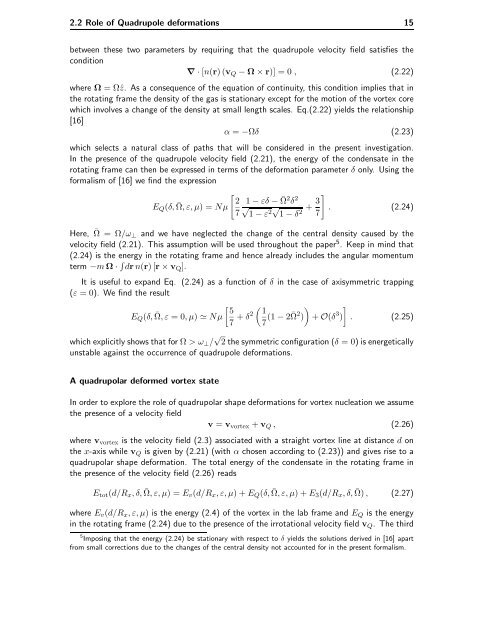Bose-Einstein Condensates in Rotating Traps and Optical ... - BEC
Bose-Einstein Condensates in Rotating Traps and Optical ... - BEC
Bose-Einstein Condensates in Rotating Traps and Optical ... - BEC
Create successful ePaper yourself
Turn your PDF publications into a flip-book with our unique Google optimized e-Paper software.
2.2 Role of Quadrupole deformations 15<br />
between these two parameters by requir<strong>in</strong>g that the quadrupole velocity field satisfies the<br />
condition<br />
∇ · [n(r)(vQ − Ω × r)] = 0 , (2.22)<br />
where Ω =Ωˆz. As a consequence of the equation of cont<strong>in</strong>uity, this condition implies that <strong>in</strong><br />
the rotat<strong>in</strong>g frame the density of the gas is stationary except for the motion of the vortex core<br />
which <strong>in</strong>volves a change of the density at small length scales. Eq.(2.22) yields the relationship<br />
[16]<br />
α = −Ωδ (2.23)<br />
which selects a natural class of paths that will be considered <strong>in</strong> the present <strong>in</strong>vestigation.<br />
In the presence of the quadrupole velocity field (2.21), the energy of the condensate <strong>in</strong> the<br />
rotat<strong>in</strong>g frame can then be expressed <strong>in</strong> terms of the deformation parameter δ only. Us<strong>in</strong>g the<br />
formalism of [16] we f<strong>in</strong>d the expression<br />
EQ(δ, ¯ <br />
2 1 − εδ −<br />
Ω,ε,µ)=Nµ<br />
7<br />
¯ Ω2δ2 √<br />
1 − ε2 √ <br />
3<br />
+ . (2.24)<br />
1 − δ2 7<br />
Here, ¯ Ω=Ω/ω⊥ <strong>and</strong> we have neglected the change of the central density caused by the<br />
velocity field (2.21). This assumption will be used throughout the paper5 . Keep <strong>in</strong> m<strong>in</strong>d that<br />
(2.24) is the energy <strong>in</strong> the rotat<strong>in</strong>g frame <strong>and</strong> hence already <strong>in</strong>cludes the angular momentum<br />
term −m Ω · dr n(r)[r × vQ].<br />
It is useful to exp<strong>and</strong> Eq. (2.24) as a function of δ <strong>in</strong> the case of axisymmetric trapp<strong>in</strong>g<br />
(ε =0). We f<strong>in</strong>d the result<br />
EQ(δ, ¯ <br />
5 1<br />
Ω,ε=0,µ) Nµ + δ2<br />
7 7 (1 − 2¯ Ω 2 <br />
) + O(δ 3 <br />
) . (2.25)<br />
which explicitly shows that for Ω >ω⊥/ √ 2 the symmetric configuration (δ =0) is energetically<br />
unstable aga<strong>in</strong>st the occurrence of quadrupole deformations.<br />
A quadrupolar deformed vortex state<br />
In order to explore the role of quadrupolar shape deformations for vortex nucleation we assume<br />
the presence of a velocity field<br />
v = vvortex + vQ , (2.26)<br />
where vvortex is the velocity field (2.3) associated with a straight vortex l<strong>in</strong>e at distance d on<br />
the x-axis while vQ is given by (2.21) (with α chosen accord<strong>in</strong>g to (2.23)) <strong>and</strong> gives rise to a<br />
quadrupolar shape deformation. The total energy of the condensate <strong>in</strong> the rotat<strong>in</strong>g frame <strong>in</strong><br />
the presence of the velocity field (2.26) reads<br />
Etot(d/Rx,δ, ¯ Ω,ε,µ)=Ev(d/Rx,ε,µ)+EQ(δ, ¯ Ω,ε,µ)+E3(d/Rx,δ, ¯ Ω) , (2.27)<br />
where Ev(d/Rx,ε,µ) is the energy (2.4) of the vortex <strong>in</strong> the lab frame <strong>and</strong> EQ is the energy<br />
<strong>in</strong> the rotat<strong>in</strong>g frame (2.24) due to the presence of the irrotational velocity field vQ. Thethird<br />
5 Impos<strong>in</strong>g that the energy (2.24) be stationary with respect to δ yields the solutions derived <strong>in</strong> [16] apart<br />
from small corrections due to the changes of the central density not accounted for <strong>in</strong> the present formalism.




